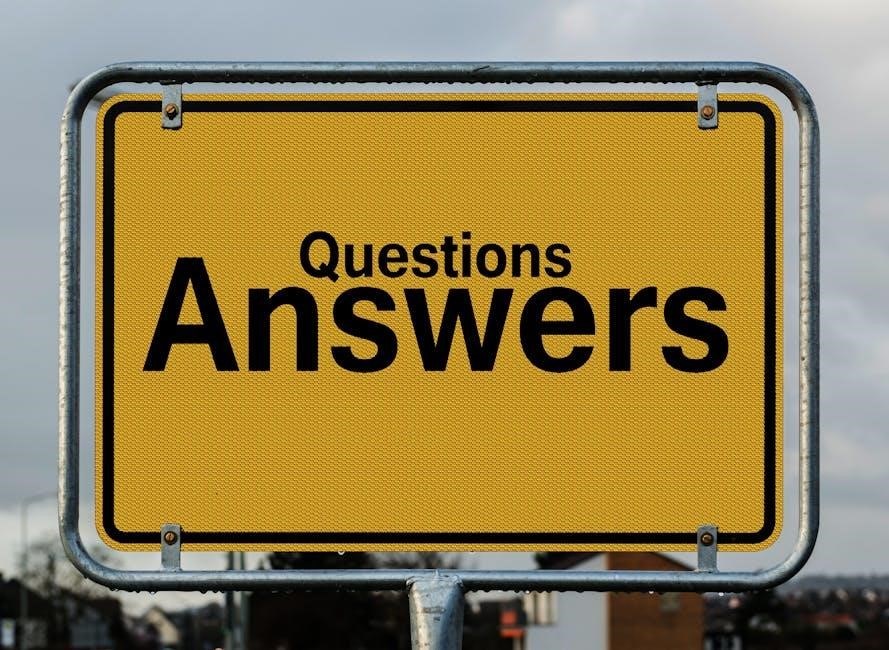A possessive noun shows ownership or possession of something․ It is formed by adding an apostrophe and an ‘s’ to singular nouns or placing an apostrophe after the ‘s’ in plural nouns․ Possessive nouns clarify who or what owns an object, making sentences more specific and clear․

Formation Rules of Possessive Nouns
Singular nouns form possessives by adding an apostrophe and ‘s’ (e․g․, cat → cat’s)․ Plural nouns ending in -s add an apostrophe after the ‘s’ (e․g․, cats → cats’)․ Irregular plurals follow the same rule, ensuring clarity in ownership․
Singular Possessive Nouns
Singular possessive nouns are used to show ownership by one person, place, or thing․ To form a singular possessive noun, add an apostrophe and an ‘s’ to the noun․ For example, “cat” becomes “cat’s,” and “dog” becomes “dog’s․” This rule applies to most singular nouns, regardless of their ending․ For instance, “woman” becomes “woman’s,” and “bus” becomes “bus’s․”
Some nouns ending in ‘s’ or ‘x’ may still follow this rule, such as “James” becoming “James’s․” The apostrophe and ‘s’ are added to the end of the noun to indicate possession․ Singular possessive nouns are often used before another noun to show ownership, as in “the cat’s toy” or “the woman’s book․”
Practice exercises in worksheets can help reinforce this concept․ For example, students might rewrite sentences like “The tail belongs to the dog” as “The dog’s tail․” Such activities ensure clarity in understanding and using singular possessive nouns correctly in sentences․
Plural Possessive Nouns
Plural possessive nouns indicate ownership by more than one person, place, or thing․ To form a plural possessive noun, add an apostrophe after the plural ‘s’ ending․ For example, “cats” becomes “cats'” and “dogs” becomes “dogs’․” This rule applies to most regular plural nouns․ For instance, “boys” becomes “boys'” and “girls” becomes “girls’․”
Irregular plural nouns, such as “children” or “men,” also follow this rule by adding an apostrophe after the final letter․ For example, “children” becomes “children’s” and “men” becomes “men’s․” Plural possessive nouns are used before another noun to show joint ownership, as in “the cats’ toys” or “the boys’ book․”
Worksheets often include exercises like rewriting sentences to practice this concept․ For example, “The toys belong to the cats” becomes “The cats’ toys․” Such activities help students master the correct formation and usage of plural possessive nouns in various contexts․ Regular practice ensures clarity and accuracy in their application․
Irregular Plural Possessive Nouns
Irregular plural possessive nouns are formed differently from regular plural nouns․ These nouns do not end with an “s” in their plural form, so the possessive is created by adding an apostrophe and an “s․” For example, “children” becomes “children’s,” and “men” becomes “men’s․” Similarly, “women” becomes “women’s,” and “feet” becomes “feet’s․”
Other irregular plurals, such as “teeth” or “people,” also follow this rule․ For instance, “teeth’s” or “people’s․” This applies to all irregular plural nouns, regardless of their ending․ Worksheets often include exercises to practice identifying and forming these irregular plural possessive nouns, helping learners master their correct usage․
It’s important to distinguish irregular plural possessive nouns from singular possessive forms․ For example, “knife’s” (singular) versus “knives’” (plural)․ This distinction ensures clarity in sentences, such as “The knives’ blades were sharp․” Practice exercises in worksheets help reinforce this concept, making it easier to use irregular plural possessive nouns correctly in writing and speech․ Regular practice with these forms is essential for fluency in English grammar․
Compound Possessive Nouns
Compound possessive nouns are formed when two or more nouns work together as a single unit to show ownership․ These nouns can be compound words or phrases connected by “and” or “or․” The possessive form is created by adding an apostrophe and an “s” to the last noun in the compound․ For example, “mother-in-law’s house” or “Tom and Jerry’s toys․”
In cases where the compound is connected by “or,” the possessive is added to the last noun, such as “Jack or Jill’s book․” Worksheets often include exercises to practice forming and identifying compound possessive nouns․ These exercises may involve rewriting sentences, filling in the blanks, or choosing the correct possessive form from multiple options․
Understanding compound possessive nouns is crucial for clear and accurate communication in writing․ Practice with these forms helps learners avoid confusion and ensures proper grammar usage․ Worksheets with answers provide a structured way to master this concept, making it easier to apply in real-life scenarios․ Regular practice strengthens the ability to use compound possessive nouns effectively․

Types of Possessive Nouns
Possessive nouns are categorized into singular and plural forms․ Singular possessive nouns add ‘s or ‘s’, while plural possessive nouns add ‘s after the existing ‘s․ Irregular plural nouns form possessives differently, such as ‘children’s toys’․ Understanding these types enhances clear communication in writing and speech․
A singular possessive noun indicates ownership by one person, place, or thing․ It is formed by adding an apostrophe and an ‘s’ to the noun, e․g․, cat → cat’s toy․ For nouns ending in ‘s,’ such as Thomas, the possessive form is Thomas’s book․ This rule applies to both common nouns (e․g․, dog → dog’s bone) and proper nouns (e․g․, Alice → Alice’s hat)․ Singular possessive nouns are essential for showing clear ownership in sentences, making communication precise and unambiguous․
Worksheets on singular possessive nouns often include exercises like filling in the blanks, rewriting phrases, and identifying correct forms․ These activities help learners master the concept and avoid confusion with plural possessive nouns․ By practicing with these worksheets, students can improve their grammar skills and use possessive nouns confidently in their writing and speech․
Examples of singular possessive nouns include the girl’s dress, the teacher’s desk, and the baby’s bottle․ These nouns clearly indicate that the item belongs to one individual, making the meaning of the sentence clear․ Worksheets with answers provide a structured way to practice and reinforce this fundamental grammar concept․
A plural possessive noun shows ownership by more than one person, place, or thing․ It is formed by adding an apostrophe after the plural ‘s’ ending, e․g․, cats → cats’ toys․ For irregular plural nouns like children or men, the possessive form is created by adding an apostrophe and an ‘s’ (e․g․, children’s playground, men’s club)․ This rule applies to both common and proper nouns, such as Smiths → Smiths’ house or ladies → ladies’ room․
Worksheets on plural possessive nouns often include exercises like sentence completion, identifying correct forms, and rewriting phrases․ These activities help learners distinguish between singular and plural possessive nouns, avoiding common mistakes․ By practicing with these worksheets, students can enhance their understanding of possessive nouns and use them accurately in various contexts․
Examples of plural possessive nouns include the boys’ bikes, the teachers’ lounge, and the horses’ stable․ These nouns clearly indicate shared ownership, making the sentence’s meaning precise․ Worksheets with answers provide a practical way to master this grammar concept and improve overall language proficiency․

Importance of Possessive Nouns in English Grammar
Possessive nouns are essential in English grammar as they indicate ownership or possession․ They help clarify who or what owns something, reducing ambiguity in sentences․ For example, “the boy’s book” clearly shows that the book belongs to the boy, while “the boys’ books” indicates multiple boys own the books․
Using possessive nouns correctly enhances communication, making sentences more precise and specific․ They are vital for expressing relationships between nouns, such as in “the teacher’s desk” or “the cat’s tail”․ Proper use of possessive nouns also demonstrates grammatical accuracy, which is crucial for effective writing and speaking․
Worksheets with answers provide practical exercises to master possessive nouns, helping learners avoid common mistakes․ These resources include fill-in-the-blanks, sentence formation, and rewriting tasks․ Regular practice with such worksheets ensures a strong foundation in grammar, improving overall language proficiency․

Possessive Nouns Worksheets with Answers
Possessive nouns worksheets with answers provide exercises like fill-in-the-blanks, sentence formation, and rewriting tasks․ They include answers for self-assessment and are available in PDF format, making them easy to download and use for practice․
Definition and Purpose
Possessive nouns worksheets are educational tools designed to help learners understand and practice forming possessive nouns․ These exercises typically include activities such as filling in the blanks, creating sentences, and rewriting phrases using correct possessive forms․ The primary purpose of these worksheets is to reinforce grammar skills, specifically the ability to show ownership through nouns․ By completing these exercises, students can improve their understanding of how to add apostrophes and ‘s’ appropriately to both singular and plural nouns․ The inclusion of answers allows for self-assessment, enabling learners to check their progress and identify areas for further practice․ Worksheets are especially useful for students at various proficiency levels, from beginners learning the basics to advanced learners refining their skills․ They are often available in PDF format, making them easily accessible and printable for classroom or home use․ Regular practice with these resources helps build confidence and mastery in using possessive nouns effectively in written and spoken English․
Types of Worksheets
Possessive nouns worksheets with answers come in various formats to cater to different learning needs․ One common type is the fill-in-the-blanks worksheet, where students complete sentences by adding the correct possessive noun․ Another type is sentence formation exercises, which require learners to rewrite phrases using possessive forms․ Multiple-choice questions are also popular, offering options for students to identify the correct possessive noun․ Additionally, mixed exercises combine these activities to provide a comprehensive practice․ Some worksheets focus on singular possessive nouns, while others emphasize plural possessive nouns or irregular forms․ For advanced learners, there are compound possessive noun exercises․ These resources are often available in PDF format, making them easy to download and print․ Many worksheets include answer keys, allowing students to self-assess their progress․ Whether for classroom use or independent study, these diverse worksheet types ensure that learners can practice possessive nouns in a structured and engaging way․

Creating Effective Possessive Nouns Worksheets
Effective worksheets should include clear instructions, varied exercises like fill-in-the-blanks, sentence formation, and multiple-choice questions․ Ensure answers are provided for self-assessment․ Use simple language and organize content logically to make learning engaging and straightforward for all skill levels․
Steps to Create Worksheets
Creating effective possessive nouns worksheets involves several organized steps․ First, identify the target audience to tailor the difficulty level․ Next, define clear learning objectives, such as understanding singular and plural possessive forms․ Then, design exercises like fill-in-the-blanks, sentence formation, and multiple-choice questions․ Include a variety of sentences to cover different contexts․ Add an answer key for self-assessment and teacher reference․ Ensure the layout is visually appealing and easy to navigate․ Finally, review and test the worksheet to eliminate errors and ensure clarity․ These steps help create engaging and educational resources for learners to master possessive nouns effectively․

PDF Resources for Worksheets
Download free PDF worksheets from reliable sources like Super Teacher Worksheets and K5 Learning․ These resources offer printable exercises, answer keys, and clear instructions, making learning possessive nouns easy and accessible for students of all levels․
Benefits of Using PDF Worksheets
PDF worksheets offer numerous benefits for learning possessive nouns․ They are portable and can be easily downloaded, ensuring access to practice materials anytime, anywhere․ PDFs maintain consistent formatting across devices, providing a reliable learning experience․ Many PDF worksheets include answer keys, allowing students to self-assess and track progress․ They also often feature interactive elements like fillable fields and clickable buttons, making practice engaging․ PDFs are cost-effective, as they are widely available for free on platforms like Super Teacher Worksheets and K5 Learning․ Teachers can print multiple copies without formatting issues, making them ideal for classroom use․ Additionally, PDFs reduce paper waste, as they can be completed digitally․ Overall, PDF worksheets provide a flexible, efficient, and eco-friendly way to master possessive nouns․

Using Worksheets for Learning
Worksheets are effective tools for mastering possessive nouns․ They provide structured exercises suitable for classrooms or self-study․ Interactive elements and answer keys enhance learning․ Printable or digital, they offer flexible practice, ensuring comprehensive understanding of possessive noun usage․
Strategies for Effective Use
Using possessive noun worksheets effectively requires a structured approach․ Begin with identifying the learner’s skill level to tailor exercises accordingly․ Start with simple fill-in-the-blank or sentence completion tasks for beginners․ Gradually introduce more complex exercises, such as rewriting sentences or identifying correct possessive forms in context․
Incorporate visual aids and interactive elements to engage learners․ Use answer keys to provide immediate feedback, helping learners track their progress․ Encourage peer review and group activities to foster collaborative learning․ For advanced learners, include error analysis tasks to refine their understanding of possessive noun rules․
Ensure worksheets are aligned with curriculum goals and include a variety of question types, such as multiple-choice, true/false, and short-answer questions․ Regularly review and update worksheets to address common mistakes and reinforce key concepts․ By integrating these strategies, worksheets become a powerful tool for mastering possessive nouns․
Possessive nouns are a fundamental concept in English grammar, essential for expressing ownership and possession․ Worksheets with answers provide an effective way to practice and master this topic, offering structured exercises and immediate feedback․ They cater to different skill levels, from basic fill-in-the-blank tasks to more complex sentence rewriting․
Using worksheets ensures learners can identify and correct common mistakes, such as confusing singular and plural possessive forms․ The inclusion of answer keys allows for self-assessment, helping learners track their progress and understand areas needing improvement․ Regular practice with these resources enhances grammar skills and overall communication clarity․
Beyond grammar, worksheets foster critical thinking and problem-solving abilities․ They are a valuable tool for educators and self-learners alike, making the learning process engaging and efficient․ Consistent use of possessive noun worksheets leads to mastery and confidence in using this essential grammatical concept․

Best Practices for Teaching
When teaching possessive nouns, it is essential to use a combination of interactive and engaging methods to ensure effective learning․ Start by introducing the basics of singular and plural possessive nouns using clear examples and visuals․ Incorporate worksheets with answers to provide structured practice and immediate feedback, helping students identify and correct mistakes․
Encourage students to work in pairs or small groups to complete exercises, fostering collaboration and peer learning․ Use real-life scenarios and relatable examples to make the concept of possession more tangible․ For instance, ask students to create sentences about their own belongings using possessive nouns․
For advanced learners, introduce irregular plural possessive nouns and compound possessive structures․ Provide opportunities for self-assessment by including answer keys in worksheets, allowing students to track their progress․ Finally, integrate technology, such as online quizzes or interactive games, to make learning possessive nouns dynamic and fun․
By combining these strategies, educators can create a comprehensive and engaging learning experience that helps students master possessive nouns effectively․

Additional Resources
For further practice and reinforcement, numerous online platforms offer comprehensive resources on possessive nouns․ Websites like Super Teacher Worksheets and YourDictionary provide downloadable PDF worksheets with answers, catering to various skill levels․ These resources include exercises such as fill-in-the-blanks, sentence formation, and rewriting phrases using possessive nouns․ Additionally, K5 Learning and Literacy Services offer printable worksheets designed for different grades, ensuring targeted practice for learners of all ages․
Many of these resources are free and easily accessible, making them ideal for both classroom use and self-study․ They often include answer keys, allowing users to check their progress and understand common mistakes․ Some platforms also offer interactive quizzes and games to make learning possessive nouns engaging and fun․ By utilizing these additional resources, learners can reinforce their understanding and mastery of possessive nouns effectively․
Exploring these resources can provide a well-rounded learning experience, helping students achieve proficiency in using possessive nouns confidently․
